Whiting are one of the most desirable table species found in south east Queensland. For their size they fight fantastic, their fillets are to die for and it’s a lot of fun chasing them.
Recently we went fishing with Kord Lukas from L.Wilson to get a handle on how you can get more and bigger whiting in your bag – and let’s be honest, who wouldn’t want a few more or a few bigger whiting to take home? And this is definitely not the only, nor necessarily the best way to catch more and bigger whiting. It’s just one of the many ways you can catch a feed of these tasty fish: this variety of good tactics making whiting so popular amongst recreational fishers.
So let us start at the beginning and talk about bait, then move through all the important aspects of whiting fishing including tackle, location and timing. Lastly we’ll cover filleting your catch for the best results so you can enjoy the spoils of your efforts.
One of the great aspects of whiting fishing in southeast Queensland is that you can mostly collect all the bait you need near your fishing area. Things like yabbies, sand worms, beachworms and estuary mud worms can be collected with a bit of hard work and sweat.
Without going into too much detail on each, as it would fill an entire magazine, beach worms can be gathered from any of the surf beaches with some skill and practice. Mark Ward did a piece on beach worming in QFM’s August 2011 issue and on www.fishingmonthly.com.au in the Feature Articles section in December.
Yabbies are perhaps the simplest to target with a bait pump. Simply look for a sand/mud flat at low tide, find the yabby holes and start sucking up the mud and yabbies. The kids love chasing after the yabbies as they come squirting out in a black muddy mess – that is until a big male claw grabs onto little fingers!
Sand worms can be pumped in the same areas as yabbies, except the process is entirely different. Sand worms need to be blown out of their holes. You will see two holes close together and this is the front and back entrance of a sand worms U-shaped home. Place the bait pump over one hole and pump air into it and the sandworm is ejected from the other hole. Simple.
The toughest to gather, and as is always the case the best baits for whiting are the mud or estuary worms. There are several species that can be legally gathered, however I’d encourage anyone wanting to gather their own to research the laws and regulations on what you can do and where you can collect.
These mud or estuary worms generally have to be raked or shovelled out of the mud and there are very tight restrictions on where this can happen so check before raking any mud for worms. It’s hard and dirty work where you literally fork over the mud and search through it for worms.
All the effort is worth it and I’d encourage anyone to give it a go so you at least have some inkling as to why live worms cost so much at a tackle shop. Not a job I’d be doing any time soon!
This is where this article could blow right out as the changes in tackle and technology now mean there are a vast number of tackle options for whiting anglers. With this in mind, let’s consider two different scenarios, fishing with mono and fishing with braid. Both require slightly different tackle.
This is the more traditional form of whiting fishing in southeast Queensland. Tackle that includes the omnipresent Alvey reel, long whippy rod and some 6lb monofilament that threatens to break if you breath too heavily on it. The entire system is brilliant and works incredibly well on whiting.
At the system’s heart is the long rod. These rods are designed to take all the shock out of the fishing and allow the angler to steer the fish around obstacles such as boat motors, other rods and weed beds and rocks. The long rod also softens everything up and stops the incidence of hooks pulling. Kord recommends rods from 9’ through to 10’6”.
Small Alvey reels, in the form of the 55B, are ideal as they match the long rods well and provide a simple casting mechanism that everyone can use. They also fish 6lb mono well.
In more recent times anglers of all persuasions have embraced braid and its thin diameter for breaking strain has a number of benefits for whiting fishers, not the least being the ability to use far less lead in any given rig.
The outfit is fairly similar to the traditional outfit apart from the threadline reel used. The long rod is still important as there is even less give in braid than there is in mono and the whippiness of the rod helps keeps hooks in the fish’s mouth.
The big surprise is the reel, which has to be a little larger than you would think to balance out the longer rod. A 3000 sized reel is about right, however some use larger reels. You do not need anything fancy with the threadline you choose, and it is best to go for a mid to low priced reel that has a proven track record of durability.
Understand that whiting are not going to scream off metres and metres of line, and fancy bait runner-style devices are not necessary.
It’s kind of refreshing to not have to go to the top end to get the best performance and the KISS principle should be kept paramount in all your whiting fishing endeavours.
The technique is simplicity in itself. As Kord explained “I look for fairly shallow water with bottom undulations”.
These undulations provide feeding channels and a little bit more depth for the whiting to sit in while the tide rises and falls.
“I find it’s best to use a small sinker that just holds bottom. I don’t want the bait swirling around all over the place and would rather be too big on the sinker than too small,” said Kord.
“The rig is simplicity in itself with a small running ball sinker leading to a swivel, then a 4lb mono or fluorocarbon leader of 60cm. This finishes with a hook, the style of which you can choose but most use a worm-style hook like the Mustad Bloodworm or Long Baitholder in size 4 or 6, which are offset hooks. The other option is a size 4 Fine Worm hook from Mustad, which is a straight pattern hook.
“More recently though I have been using circle hooks, the Mustad Demon in size 6, 4 or 2 has been brilliant at hooking fish in the corner of the mouth meaning it’s easy to release unwanted whiting and it has really reduced the number of gut hooked whiting,” said Kord.
This rig is cast out behind the boat and the rod left in the rod holder to essentially hook the fish itself. This is where the circle hook is at its best and all you need to do is lean back on the rod to ensure the fish is well hooked.
A net is a handy tool, as is a pair of braid scissors for cutting up the worm into small pieces.
“And on the worms,” said Kord, “Make sure you only cover the hook. There is no point having lots of dangling bits that are pointless. You want the whiting to eat the entire bait so the hook point gets into its mouth and makes it easier to hook the fish.”
A quick snapshot of this information will see you using long rods with light line and a very light leader that is short. Sinker weight is kept to a minimum to hold the rig on the bottom amongst the sand undulations in 1-3m of water. We’ll also be fishing on a rising tide, following the tide up the sand banks. We let the tackle do most of the work in hooking the fish and simply wind them in and enjoy a feed of fresh whiting. Simple.
Whiting are a fun fish to target and come up fantastically on the plate. They are not difficult to target or catch and the tackle and techniques are a wonderful change from high-end graphite and million-ball-bearing reels tournament and lure anglers crave.
Simplicity and relaxation finished off with a cold beer and a tasty feed. Now that’s fishing.
Facts
Whiting Tackle
Mustad Bloodworm size 6-2
Mustad Long Baitholder size 6-2
Mustad Fine Work size 4-2
Mustad Demon size 6-2
L.Wilson Crusoe Rod 4 wrap, 10’, threadline reel seat
3000 sized threadline reel
Bruce Alvey Special, 10’6”, Alvey reel seat
Alvey 55B
6lb braid or monofilament
various ball sinkers to suit conditions
small rolling swivels
4lb monofilament or fluorocarbon leader
small landing net
Facts
Queensland whiting regulations
| Species | Minimum Size | Possession limit |
|---|---|---|
| Summer/sand, goldline and northern | 23cm | Combined limit of 30 in total of these whiting species |
| Trumpeter (winter) | No limit | 50 |
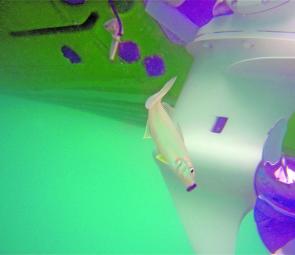
When the fish get near the boat, the long rods make it easier to keep them away from obstacles such as motors, transducers and other obstructions.
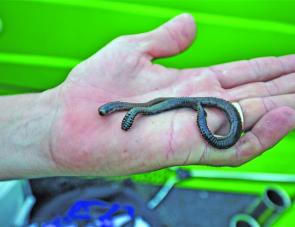
Worms are a favoured bait with whiting anglers everywhere. Use a pair of braid scissors to segment the worm into small pieces that are easily taken by the whiting.
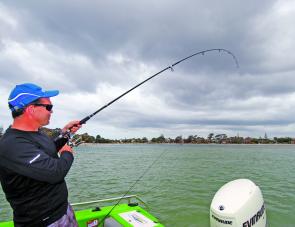
The long rods provide great shock absorption and allow a fantastic spread of baits out the back of the boat.
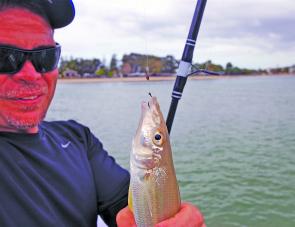
Circle hooks are becoming more popular in all baitfishing scenarios as they tend to hook fish in the mouth more often making for easy release of unwanted fish.
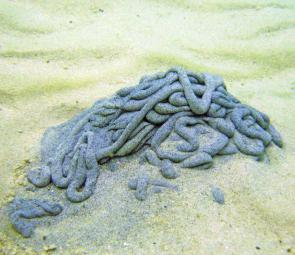
If you pop on a snorkel and mask you’ll see mounds of worm diggings. This is a great sign that whiting will not be too far away.
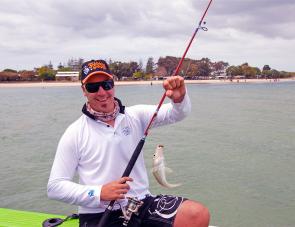
Greg Livingstone loves killing anything edible and with whiting he can amass a small mound of tiny carcasses just ripe for the eating.




